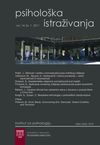Belgrade Adolescent Personality Inventory: Bridging the Gap between Personality Assessment in Children and Adults
Belgrade Adolescent Personality Inventory: Bridging the Gap between Personality Assessment in Children and Adults
Author(s): Tamara Džamonja-Ignjatović, Marko Milanović , Vesna DukanacSubject(s): Psychology, Social psychology and group interaction, Personality Psychology
Published by: Филозофски факултет, Универзитет у Београду
Keywords: temperament; character; adolescence; personality development and structure;
Summary/Abstract: Personality inventories for assessment and study temperament and character of adolescents, an age critical for the finalisation of both normal and pathological mental development, have not been specifically developed. In this paper, we introduce a new personality inventory based on Cloninger’s Psychobiological model of personality to assess adolescents from 14 to 18 years of age (the Belgrade Adolescent Personality Inventory – BAPI), which bridges the gap between personality assessment in children and adults. The BAPI is a 46-item Likert scale inventory derived from previous studies using the TCI and JTCI on the Serbian sample. The psychometric properties of the BAPI were tested on the sample of 535 secondary school students in Serbia, aged 15 to 16. In order to assess the fit of the model, the Confirmatory factor analysis (CFA) was performed. The differences between sexes were analysed by MANOVA, while the Latent class analysis (LCA) was applied in order to identify different adaptation profiles among adolescents. The BAPI scales had a satisfactory internal consistency (.66 – .80.) considering the small number of items (5–6) in each scale. The confirmatory factor analysis (CFA) generally supported the main dimensions of temperament and character, as postulated by Cloninger. The only exception was Novelty Seeking, which best fitted a two-factor solution, Explorative curiosity and Impulsivity, separating the “good” (curious, inquisitive, creative) and “bad” (impulsive, impatient, disorderly) facets of this trait. Such polarity of Novelty Seeking could be specific for personality development and behaviour disorders in adolescence. The LCA differentiated the personality profiles of well-adapted adolescents from those at risk for maladaptation that manifested low character traits, lack of Persistence and high Novelty seeking Impulsivity subscale. The results support the construct validity of the BAPI and thus provide the basis for its practical application in personality assessment of adolescents and contribute to the theoretical understanding of personality structure and the risk of psychopathology in adolescence.
Journal: Psihološka istraživanja
- Issue Year: 17/2014
- Issue No: 1
- Page Range: 35-53
- Page Count: 19
- Language: English

